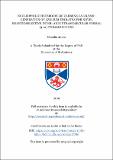Files in this item
Nucleophilic heterocyclic carbene catalysis : generation of azolium enolates for novel enantioselective inter- and intramolecular formal [4+2] cycloadditions
Item metadata
| dc.contributor.advisor | Smith, Andrew David | |
| dc.contributor.author | Attaba, Nassilia | |
| dc.coverage.spatial | xvii, 176 p. | en_US |
| dc.date.accessioned | 2019-05-29T14:20:28Z | |
| dc.date.available | 2019-05-29T14:20:28Z | |
| dc.date.issued | 2019-06-26 | |
| dc.identifier.uri | https://hdl.handle.net/10023/17780 | |
| dc.description.abstract | N-Heterocyclic carbene (NHC)-catalysed processes that utilise azolium enolates intermediates have been used for a broad range of transformations such as enantioselective cycloaddition, protonation, halogenation, Mannich reactions and desymmetrisation processes. One efficient way to quickly build molecular complexity is through cycloadditions such as formal [4+2] cycloadditions. In this context, ketenes, aldehydes, esters, enals and α-halo aldehydes have been used in numerous reactions for the construction of 6-membered rings. Nevertheless, the current limitations include lack of stability from the precursors and unwanted side-reactions. To broaden the synthetic utility of azolium enolates, alternative precursors are necessary This has been addressed in this thesis in novel inter- and intramolecular formal [4+2] cycloadditions using α-aroyloxyaldehydes and enone-acids as bench-stable azolium enolate precursors. An intermolecular NHC-catalysed [4+2]-hetero-Diels-Alder process using α-aroyloxyaldehydes as azolium enolate precursors and trichloromethyl ketone Michael acceptors was first explored. This methodology led to the formation of syndihydropyranones in up to 95% yield, >95:5 dr and >99:1 er. A sequential [4+2] cycloaddition/nucleophilic ring-opening with amines or alcohols led to the selective synthesis of either highly functionalised diamides or γ-ester amide derivatives in up to 90% with excellent diastereo- and enantioselectivity. This highlighted the ability of trichloromethyl ketones to act as amide surrogates. An investigation of using carboxylic acids bearing a pendant enone, referred as enone-acid, led to the first NHC-catalysed formal [4+2] cycloaddition protocol. A range of dihydrobenzofurans were accessed in moderate to high yield, and high to excellent diastereoand enantioselectivity. This novel methodology could be extended to the synthesis of syndihydropyranone and syn-dihydrochromenone derivatives in moderate to high yield and excellent diastereo- and enantioselectivity. | en |
| dc.language.iso | en | en_US |
| dc.publisher | University of St Andrews | |
| dc.relation | Attaba , N , Taylor , J E , Slawin , A M Z & Smith , A D 2015 , ' Enantioselective NHC-catalyzed redox [4+2]-hetero-Diels-Alder reactions using α,β-unsaturated trichloromethyl ketones as amide equivalents ' , The Journal of Organic Chemistry , vol. 80 , no. 19 , pp. 9728–9739 . https://doi.org/10.1021/acs.joc.5b01820 | |
| dc.relation.uri | http://hdl.handle.net/10023/9430 | |
| dc.subject.lcc | QD262.A88 | |
| dc.title | Nucleophilic heterocyclic carbene catalysis : generation of azolium enolates for novel enantioselective inter- and intramolecular formal [4+2] cycloadditions | en_US |
| dc.type | Thesis | en_US |
| dc.contributor.sponsor | European Research Council (ERC) | en_US |
| dc.type.qualificationlevel | Doctoral | en_US |
| dc.type.qualificationname | PhD Doctor of Philosophy | en_US |
| dc.publisher.institution | The University of St Andrews | en_US |
| dc.publisher.department | School of Chemistry | en_US |
| dc.identifier.doi | https://doi.org/10.17630/10023-17780 |
This item appears in the following Collection(s)
Items in the St Andrews Research Repository are protected by copyright, with all rights reserved, unless otherwise indicated.

